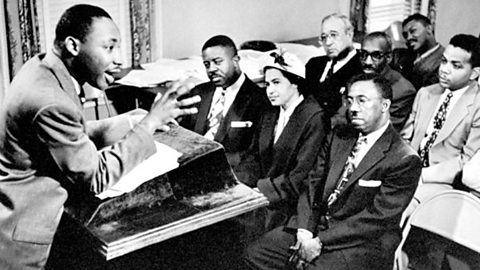Emergence of the civil rights movement - continued
The Montgomery Bus Boycott and Rosa Parks
Despite the US Supreme CourtThe ultimate court of appeal in the USA. It makes the final decision on whether a law is permitted by the US Constitution. ruling that education had to be desegregationRemoval of laws that separate people from different races in public places and day-to-day life. there was no change in the segregationThis meant that white people and black people had to live separately. The areas of society affected by segregation included churches, hospitals, theatres and schools. of other areas of southern society. Places such as leisure areas, water fountains and transport were still segregated, but the National Association for the Advancement of Colored People NAACPThe National Association for the Advancement of Colored People was created in 1909 to eliminate race-based discrimination across the United States of America. was working to change that.
Rosa Parks worked at a department store in Montgomery, Alabama. She was an active member of her local NAACP branch.
In December 1955, Parks was arrested for refusing to give up her bus seat to a white passenger. This was not the first time she had refused to give up her seat, but this time her civil disobedienceA form of protest where a person refuses to follow an unjust law. prompted a city-wide response. The NAACP, alongside other local civil rights organisations such as the Womenâs Political Council, decided to organise a city-wide bus boycottTo refuse to take part in, buy or use something in order to show disapproval or bring about a change. on the day of Parksâ trial. When the day came, most black people observed the boycott.
Around 70 per cent of the bus users in Montgomery were black, so the boycott meant the bus company's profits were greatly reduced. After Parks was found guilty and fined $10, a longer bus boycott was planned.
The Montgomery Improvement Association and Dr Martin Luther King Jnr
To organise the longer boycott, following Parksâ arrest, the local African American community created the Montgomery Improvement AssociationMIAThe Montgomery Improvement Association was founded to organise the 1955 bus boycott. In response to Parksâ arrest, the MIAâs actions were:
- to boycott the buses until they were desegregated
- to create and organise a carpool system
- to elect Martin Luther King to the position of president of the MIA
During the boycott, over half of all African Americans in Montgomery used carpools, while the rest walked, rode bikes or used taxis. The MIAâs actions meant that many in the community could continue taking part in the boycott and their day-to-day activities without needing to pay for bus services. This put significant financial strain on the company that ran Montgomeryâs buses.

Kingâs position as president of the MIA allowed him to give speeches that were regularly attended by over 10,000 people. His popularity and fame increased, giving him the opportunity to promote his methods of non-violent protest, such as boycotts and rallies.
As King promoted non-violent protest, the response from his opposition was to intensify violence and hostility. King was arrested twice. Two churches were bombed in an attempt to end the boycott and silence King, Parks and the MIA. All of those who were arrested for hostilities against King and the MIA were found not guilty by all-white juries.
The NAACP and MIA worked together to fight for civil rights. In 1956, the Supreme Court ruled that the segregation rules on Montgomeryâs buses were unconstitutional If something is unconstitutional, it means that it breaks rules about how the US government should be run. and had to change. Just as with the decision in Brown v Board of Education of Topeka, this was an example of a Jim Crow lawsThe laws that introduced segregation in the US South (the laws that kept black people and white people apart). that was now illegal across the whole of the USA.
After 381 days the boycott ended. Parks and King continued to contribute to the Civil rights movementAn organised set of activities that brought about a change in the treatment of people from different races in American society. inside and outside Montgomery.
More guides on this topic
- Anti-Communism c.1945-1954 - OCR A
- African Americans c.1945-1954 - OCR A
- Broadening of the campaigns for civil rights - Race - OCR A
- Broadening of the campaigns for civil rights - Women's rights - OCR A
- Broadening of the campaigns for civil rights - Gay rights - OCR A
- Politics and protest - OCR A
- Social problems and attempts to tackle them - OCR A